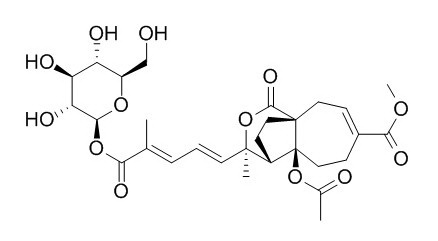Pseudolaric acid B-O-beta-D-glucopyranoside
Pseudolaric acid B-O-beta-D-glucopyranoside is a natural product from Pseudolarix amabilis.
Inquire / Order:
manager@chemfaces.com
Technical Inquiries:
service@chemfaces.com
Tel:
+86-27-84237783
Fax:
+86-27-84254680
Address:
1 Building, No. 83, CheCheng Rd., Wuhan Economic and Technological Development Zone, Wuhan, Hubei 430056, PRC
Providing storage is as stated on the product vial and the vial is kept tightly sealed, the product can be stored for up to
24 months(2-8C).
Wherever possible, you should prepare and use solutions on the same day. However, if you need to make up stock solutions in advance, we recommend that you store the solution as aliquots in tightly sealed vials at -20C. Generally, these will be useable for up to two weeks. Before use, and prior to opening the vial we recommend that you allow your product to equilibrate to room temperature for at least 1 hour.
Need more advice on solubility, usage and handling? Please email to: service@chemfaces.com
The packaging of the product may have turned upside down during transportation, resulting in the natural compounds adhering to the neck or cap of the vial. take the vial out of its packaging and gently shake to let the compounds fall to the bottom of the vial. for liquid products, centrifuge at 200-500 RPM to gather the liquid at the bottom of the vial. try to avoid loss or contamination during handling.
Mol Med Rep.2022, 26(4):299.
J Pharmaceutical Research Int.2021, 33(41A):275-284.
Pak J Pharm Sci.2018, 31:311-315
Nutrients.2024, 16(16):2612.
Molecules.2020, 25(18):4283.
Foods.2021, 10(11):2627.
Biomed Pharmacother.2024, 181:117658.
Heliyon.2024, 10(7):e28364.
Am J Chin Med.2016, 44(6):1255-1271
Foods.2023, 12(7):1355.
Related and Featured Products
Yao Xue Xue Bao. 2014 Aug;49(8):1169-74.
Metabolic pathway and metabolites of total diterpene acid isolated from Pseudolarix kaempferi.[Pubmed:
25322560]
The preliminary metabolic profile of total diterpene acid (TDA) isolated from Pseudolarix kaempferi was investigated by using in vivo and in vitro tests.
METHODS AND RESULTS:
Pseudolaric acid C2 (PC2) was identified as the predominant metabolite in plasma, urine, bile and feces after both oral and intravenous administrations to rats using HPLC-UV and HPLC-ESI/MS(n), and demethoxydeacetoxypseudolaric acid B (DDPB), a metabolite proposed to be the glucoside of PC2 (PC2G), as well as pseudolaric acid C (PC), pseudolaric acid A (PA), Pseudolaric acid A-O-beta-D-glucopyranoside (PAG), Pseudolaric acid B-O-beta-D-glucopyranoside (PBG) and deacetylpseudolaric acid A (DPA) originated from TDA could also be detected. It was demonstrated by tests that the metabolism of TDA is independent of intestinal microflora, and neither of pepsin and trypsin is in charge of metabolism of TDA, TDA is also stable in both pH environments of gastric tract and intestinal tract. The metabolites of TDA in whole blood in vitro incubation were found to be PC2, DDPB and PC2G, which demonstrated that the metabolic reaction of TDA in vivo is mainly occurred in blood and contributed to be the hydrolysis of plasma esterase to ester bond, as well as the glucosylation reaction.
CONCLUSIONS:
These results clarified the metabolic pathway of TDA for the first time, which is of great significance to the in vivo active form and acting mechanism research of P. kaempferi.
J. Nat. Prod., 2002, 65 (7), pp 1041–1044
Five New Diterpenoids from Pseudolarix kaempferi[Reference:
WebLink]
METHODS AND RESULTS:
Five new diterpenoids, pseudolaric acids F (1), G (2), and H (3), 2‘,3‘-dihydroxy-1‘-propoxypseudolarate B (4), and 6‘-O-acetylpseudolaric acid B O-β-d-glucopyranoside (5), along with nine known diterpenoids, pseudolaric acids A, B, and C1, deacetylpseudolaric acid C2, deacetylpseudolaric acid A, methyl pseudolarate A, methyl pseudolarate B, pseudolaric acid A-O-β-d-glucopyranoside, and Pseudolaric acid B-O-beta-D-glucopyranoside, were isolated from the root bark of Pseudolarix kaempferi.
CONCLUSIONS:
Their structures and stereochemistry were elucidated mainly by spectral data, especially 2D NMR techniques.



